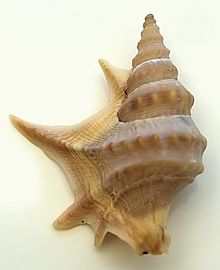
Summary
Aporrhaidae is a family of sea snails commonly called the "pelican's foot snails." The taxonomy of the Gastropoda by Bouchet & Rocroi, 2005[3] categorizes Aporrhaidae as marine gastropod mollusks in the clade Littorinimorpha.
| Aporrhaidae | |
|---|---|

| |
| A shell of Aporrhais pespelecani, from Catalonia, Spain | |
| Scientific classification | |
| Domain: | Eukaryota |
| Kingdom: | Animalia |
| Phylum: | Mollusca |
| Class: | Gastropoda |
| Subclass: | Caenogastropoda |
| Order: | Littorinimorpha |
| Superfamily: | Stromboidea |
| Family: | Aporrhaidae Gray, 1850[1] |
| Genera | |
|
See text | |
| Synonyms | |
| |
Aporrhaids are commercially important, especially in traditional fisheries.[4]
Description edit
Aporrhaids have a large lip with finger-like extensions, and a small operculum. They do not have movable eyes. Instead, their eyes are fixed at the base of each tentacle.[5]
The mollusk has one narrow foot, which renders its motion interrupted as the foot must raise the shell a tiny bit in each single movement, simultaneously pushing it forward. The motion must be repeated again and again for the mollusk to travel.[6]
Habitat edit
Aporrhaidae live on muddy and sandy bottoms, sometimes in very large populations.
Subfamilies edit
Subfamilies in the family Aporrhaidae include:
- Aporrhainae Gray, 1850 - synonym: Chenopidae Deshayes, 1865
- Arrhoginae Popenoe, 1983 - synonyms: Alariidae Koken, 1889 (inv.); Dicrolomatidae Korotkov, 1992
- † Harpagonidae Pchelintsev, 1963
- † Perissopterinae Korotkov, 1992 - synonym: Struthiopterinae Zinsmeister & Griffin, 1995
- † Spinigerinae Korotkov, 1992 (inv.)
Genera edit
There are only two Recent genera:[7][8]
- Aporrhais da Costa, 1778
- Arrhoges Gabb, 1868
- † Dicroloma Gabb, 1868
- † Drepanocheilus Meek, 1864
- † Hemichenopus Steinmann & Wilckens, 1908
- † Struthioptera Finlay & Marwick, 1937
Fossil genera within the family Aporrhaidae include:
- Alarimella Saul, 1998
- Anchura Conrad, 1860
- Antarctohoges Stilwell & Zinsmeister, 1992
- Araeodactylus Harris & Burrows, 1891
- Auriala Hacobjan, 1976
- Austroaporrhais Zinsmeister & Griffin, 1995
- Bicorempterus Gründel, 2001
- Ceratosiphon Gill, 1870
- Cultrigera Böhm, 1885
- Cuphosolenus Piette, 1876
- Cuphotifer Piette, 1876
- Cyclomolops Gabb, 1868
- Diarthema Piette, 1864
- Digitolabrum Cossmann, 1904
- Dimorphosoma Gardner, 1875
- Graciliala Sohl, 1960
- Goniocheila Gabb, 1868
- Helicaulax Gabb, 1868
- Kangilioptera Rosenkrantz, 1970
- Kaunhowenia Abdel Gawad, 1986
- Latiala Sohl, 1960
- Lispodesthes White, 1875
- Maussenetia Cossmann, 1904
- Mexopus Kiel & Perrilliat, 2001
- Monocuphus Piette, 1876
- Perissopter Tate, 1865
- Peruchilus Olsson, 1931
- Pietteia Cossmann, 1904
- Platyoptera Conrad, 1855
- Pseudanchura Kollmann, 2005
- Pterocerella Meek, 1864
- Pugioptera Pchelincev, 1953
- Strombopugnellus Koch, 1911
- Struthiochenopus Zinsmeister & Griffin, 1995
- Teneposita Loch, 1989
- Tessarolax Gabb, 1864
- Tibiaporrhais Elder, 1990
- Toarctocera Gründel, Nützel & Schulbert, 2009[9] - type species: Rostellaria subpunctata - Toarctocera subpunctata (von Munster in Goldfuss, 1826–1844)
- Trilemma Blagovetshenskiy & Shumilkin, 2006
- Tulochilus Finlay & Marwick, 1937
- Tundora Stephenson, 1941
- Ueckeritzella Gründel, 1998
- Wateletia Cossmann, 1889
References edit
- ^ Gray J. E. 1850. Figures of molluscous animals selected from various authors. Etched for the use of students by M. E. Gray. Volume 4. Longman, Brown, Green & Longmans, London. iv+219 pp. Apporhaidae at page 66.
- ^ Kiel S. & Bandel K. (1999). "The Pugnellidae, a new stromboidean family from the Upper Cretaceous". Paläontologische Zeitschrift 73(1-2): 47-58, 6 Figs., Stuttgart. PDF[permanent dead link]
- ^ Bouchet P. & Rocroi J.-P. (Ed.); Frýda J., Hausdorf B., Ponder W., Valdes A. & Warén A. 2005. Classification and nomenclator of gastropod families. Malacologia: International Journal of Malacology, 47(1-2). ConchBooks: Hackenheim, Germany. ISBN 3-925919-72-4. ISSN 0076-2997. 397 pp. http://www.vliz.be/Vmdcdata/imis2/ref.php?refid=78278
- ^ "Shells aporrhaidae". Archived from the original on 2005-03-05. Retrieved 2009-03-07.
- ^ "Aporrhaidae (Pelicans Foot)". Archived from the original on 2019-02-22. Retrieved 2009-03-07.
- ^ "TrekNature | A Pelican's foot for Ahmet Photo".
- ^ Gofas, S. (2012). Aporrhaidae. Accessed through: World Register of Marine Species at http://www.marinespecies.org/aphia.php?p=taxdetails&id=22988 on 2012-09-27
- ^ Kronenberg, G.C. 1991: The Recent species of the family Aporrhaidae. Vita marina, 41(2): 73-84.
- ^ Gründel, J., Nützel A. & Schulbert C. (24 July) 2009. Toarctocera (Gastropoda, Aporrhaidae): a new genus from the Jurassic (Toarcian/Aalenian) of South Germany and the early evolutionary history of the family Aporrhaidae. Paläontologische Zeitschrift (online), PDF
- Vaught, K.C. (1989). A classification of the living Mollusca. American Malacologists: Melbourne, FL (USA). ISBN 0-915826-22-4. XII, 195 pp.
External links edit
- Data related to Aporrhaidae at Wikispecies
- Media related to Aporrhaidae at Wikimedia Commons
- Gastropoda Stromboidea - Ulrich Wieneke and Han Stoutjesdijk


